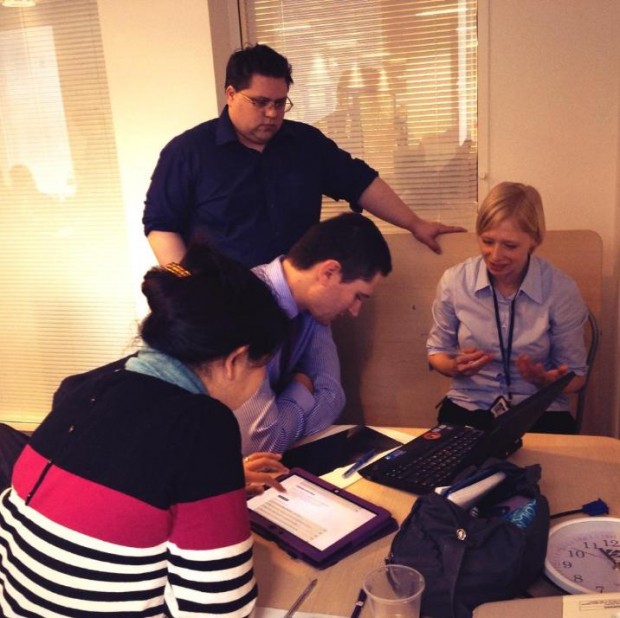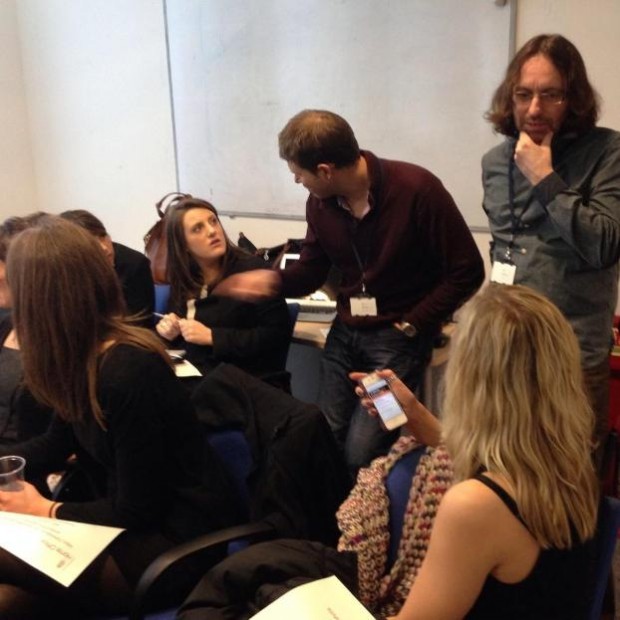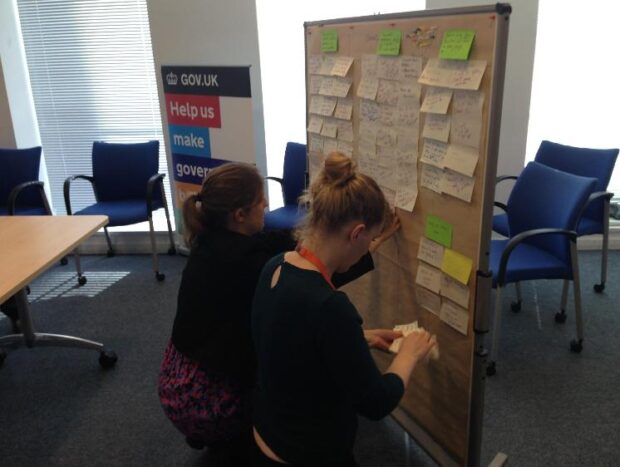Katy Arnold is a User Researcher at the Home Office.
The Home Office Visas exemplar is one of 25 projects leading the digital transformation of government. Our role is to make sure that what we build meets the needs of the people who use it. It’s called user research and it’s central to everything we are doing.
Since the beginning of the project we’ve been keen to talk to would-be users about what we’re building. We started the Beta in October, and since then we’ve spoken to over 50 people, asking for feedback on what we’re doing. This feedback has helped make the application form better: shorter, simpler, smoother and much faster to complete.
We know that we are not finished yet; far from it. But, we know that what we’ve achieved has definitely surpassed what’s gone before. We’ve made the effort to ask our users what they need from our service, and that’s given us a much better chance of making it work for them.
Reaching out to our users
A couple of weeks ago we invited users of the current Priority Service to come to our offices for a demonstration of the form. At the moment, the service uses long paper forms that often require repeated entry of the same details (for example if you are bringing a spouse or child into the country). We wanted to demonstrate the digital version of the application due for release, and give our users an opportunity to ask questions about it.
We also wanted to get some feedback on the new online form, so we asked users to bring their own devices, and made some of our devices available too. Once the demo was over we invited users to get online and go through the application, while we were around to gather feedback.
On the day
We had a lovely mix of people in the room: User researchers, developers, product owners, scrum masters and testers were in attendance; all interacting and researching with our users. Rachel and Marianne from the Priority Service team in Sheffield came along too; answering questions and noting down ideas for improvements. It was great to see; user research really is a team sport.


What we learned
This exercise allowed us to get feedback from a lot of users very quickly, and we’re already working on the things we heard. We were thrilled to find how effective the day was at involving our developers and other team members in user research. We’ll definitely do it again.

What’s next
We’re looking forward to seeing people using this thing for real. We’ll still be looking for ways to continuously improve the service as we keep adding new features and functionality; and while we are proud of what we’ve achieved so far, we know that there’s a long way to go.
Happily, our users are very keen to be involved — and we want to keep it that way. We’ll continue to test future releases with real users every week and listen to customer feedback. As our first service goes live, we’re excited to be able to measure satisfaction on the performance platform, too.
We’re always glad to hear what you think. Tell us below, or tweet us:
Join the conversation on Twitter - @GDSTeam, and don't forget to sign up for email alerts.


8 comments
Comment by Stan posted on
I think this kind of thing is what the Daily Mail failed to understand when they wrote an article complaining about gov.uk winning Design of the Year. The government site is there to help you get in, get a job done, and get out - as smoothly and quickly as possible. It's not an entertainment site. Their major complaint was that the site didn't have enough pictures!
Link to their article below:
http://www.dailymail.co.uk/news/article-2310191/And-award-goes-boring-com-Government-website-beats-100-named-worlds-best-design.html
Comment by Sophie H posted on
Hello there,
I've been attempting to take forward a divorce using the GOV web services and wanted to thank everyone for the clarity and ease of completion of the forms I have used so far. Whilst this process historically would have been a minefield for the uninitiated, with these positive developments and new formats, at last there is the chance to do it yourself. I look forward to the day that there exists the opportunity that such things can be done entirely online without the need for reference to solicitors. From the level of financial discolure required in the 'form e', nevertheless it's easy to see the challenges faced by those doing this work.
Comment by Ingrid Morris posted on
Hi Katy,
Thanks for your post. I work in customer strategy and research at VOSA. I'm currently pondering how we build a sustainable model to build feedback into all stages of our service life cycle and thinking about options to effectively resource it. eg should we be thinking about embedding researchers in all npd projects who retain a core of common standards or should NPD teams recruit or skill up their own (and how do you keep the quality and assurance up in that case) or could some be outsourced to outside providers and if so would these come from UX g cloud pool or from more traditional customer insight providers with a specialism in this area. It is really fantastic and positive that more of what we do is led by customer need but ensuring that the range of customer types and their needs are adequately represented is no mean feat! If you have any views please get in touch
Comment by simonfj posted on
Ingrid,
That's normally the first question which comes up with any form of (user) research, especially as the individual service design teams (for "inbound" UK services) will be taking feedback from OS users where language and culture will always be a problem. (Was surprised not to see a drop down box for "what language will you be using?)
It was interesting to read about the original screen sharing approach in Oct 2013. So remote working is still obviously fairly new to the GDS teams. I did point Carrie at the local government's approach, which eventually will evolve (for your research teams) from just doing a blog entry like this every day (and having a million email passed around, all cross-referencing similar discoveries) . https://knowledgehub.local.gov.uk/web/kmteam/blog/-/blogs/11365865
i.e. The user research group(s) will want their own group space. They could use the same space to take customer feedback for a particular service's design. Normally this get's a big "share with the customers?" response first up. But you'll go they way eventually, as you discover how many (with experience) designers want to help you guys along,
BTW. You'll want to have a relationship with the LGA guys anyway, for all the internal service's design at least. That way the team can go to the users and not vice versa, which is the way to do research.
Comment by Katy Arnold posted on
Thanks for your comment.
I agree it is hard work and we’re only really getting started. I’m not sure exactly what you mean by NPD, but I think where possible, you’ve got to embed user researchers and a user-centred approach into the fabric of all the work you do.
We’re starting with the exemplar services and working out from there. We’re partnering civil servants with experts in the field and building capability and skills as we go, sustainably. We will retain as much as we can in-house so that over time we build a bigger and more complete understanding of who uses our services and what they need from them. And I think user research should complement work that is already being done in “traditional customer insight” and big data research as well as working in tandem with other sources of insight, such as web analytics.
I hope that is a helpful response.
Comment by David Chassels posted on
User research on required software support has been subject to over 20 years R&D by a UK company and working with early adopters including government agencies the actually delivery without need for custom programming through innovative approach to commoditisation has been well proven....The minute you cut code you have a new legacy and in reality the users needs should see orchestration of required legacy data; a very important requirement? The UI is only one aspect so here are the requirements that government should be researching
• Process engine – orchestrating as required to ensure all works to plan
• Rules engine - reflecting real world of complexity and compliance
• Calculation engine - automating system work
• State engine - real time feed back from any point
• Workflow - everything connected in right order
• Audit trail, events, escalations - managed control and accountability
• Rapid prototyping - user involvement in build
• Time recording - supports activity based costing
• Real time reporting - become predictive
• Build mash ups - one screen multiple data sources
• Linked intelligent Ajax grids - enter data only once
• Roles and performers - people and machines indentified
• Management hierarchy - see who does what and when reallocate work
• Orchestrating legacy - recognising valuable data in legacy
• User interface dynamically created - linking people, roles, task type and data via forms for specific instances recognising that user forms needs to be specific for that task in hand and with intelligent functionality should for engaging for users
• Pre-built templates for custom documents, letters, e-mails, messages etc dynamically populated with instance specific data and edit capability in browser - automating yet giving users ultimate control over external communications
• Process and task versioning control - recognising change is inevitable
I would strongly recommend your research extends to these forums http://www.bpm.com/home/forums and BPM Guru, Digital Strategy and TechUK on Linkedin. This research published last year http://www.igi-global.com/chapter/object-model-development-engineering/78620
Sadly the advice given by GDS does not reflect such new capability as they have not undertaken such research - something being investigated – but meanwhile do your homework you will save £ms!
Comment by Katy Arnold posted on
Thanks for your comment. The work we’re doing is aimed at understanding what our users need from the services we build.
Government has been very good at spending on enterprise solutions in the past. Now we are using open source software and are sharing solutions across departments. We avoid getting locked into long term contracts with big technology providers and this is already saving taxpayers a considerable sum.
But it is all wasted effort if users don’t use what the services we provide, so we’re getting better at researching our users. It is a very different proposition from what you suggest.
Comment by Alan Catterick posted on
Katy Arnold you are quite correct. you can have all the research you want but if the outcome is not suited to the needs of the end user then the effort and resources are wasted. My work with older people in getting "on line" has shown that most research does not take into consideration the real needs of the end user. More consultation is needed at customer level to enable systems to be developed that work for the customer.